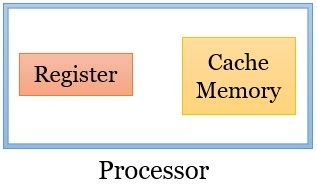Differences between Cache Memory and Register

Cache memory and registers are both types of memory storage within a computer system, but they serve different purposes and have distinct characteristics. Here are the key differences between cache memory and registers:
-
Purpose:
- Cache Memory: Cache memory is used to temporarily store frequently accessed data and instructions from main memory (RAM) in order to reduce the average memory access time and improve overall system performance. It acts as a buffer between the CPU and main memory, providing faster access to data that is likely to be needed by the CPU in the near future.
- Registers: Registers are small, high-speed storage locations within the CPU that hold data temporarily during instruction execution. They are used to store operands, intermediate results, memory addresses, and control information required for executing instructions. Registers play a critical role in the execution of machine instructions and facilitate fast data manipulation within the CPU.
-
Location:
- Cache Memory: Cache memory is located outside the CPU, typically on separate cache memory chips that are either integrated onto the CPU chip itself (L1 cache) or located nearby the CPU chip (L2 and L3 cache). Cache memory is part of the CPU's memory hierarchy but is not directly integrated into the CPU core.
- Registers: Registers are located directly within the CPU core and are integrated onto the CPU chip itself. They are part of the CPU's internal memory hierarchy and are used for storing data and control information required for executing instructions.
-
Speed:
- Cache Memory: Cache memory is relatively fast compared to main memory (RAM) but slower than registers. Accessing data from cache memory typically takes a few cycles (nanoseconds), depending on the cache level and architecture.
- Registers: Registers are the fastest type of memory storage within a computer system. Accessing data from registers takes only one cycle (a fraction of a nanosecond), making registers ideal for storing frequently accessed data and facilitating rapid data manipulation within the CPU.
-
Size:
- Cache Memory: Cache memory is larger in size compared to registers. Modern CPUs typically have multiple levels of cache memory (L1, L2, and sometimes L3 cache), with each level increasing in size but also increasing in access latency.
- Registers: Registers are small in size compared to cache memory. A CPU typically has a limited number of registers (e.g., general-purpose registers, special-purpose registers), with each register capable of holding a fixed number of bits (e.g., 32 bits or 64 bits).
-
Functionality:
- Cache Memory: Cache memory primarily serves to reduce the average memory access time and improve overall system performance by storing frequently accessed data and instructions closer to the CPU. Cache memory uses a mechanism of data caching to store copies of data from main memory.
- Registers: Registers are used for storing operands, intermediate results, memory addresses, and control information required for executing instructions. They facilitate the execution of machine instructions and data manipulation within the CPU core.
In summary, while both cache memory and registers are types of memory storage within a computer system, they serve different purposes and have distinct characteristics in terms of location, speed, size, and functionality. Registers are integrated directly into the CPU core and provide extremely fast access to data, while cache memory serves as a buffer between the CPU and main memory, providing faster access to frequently accessed data and instructions.
Thank you,
